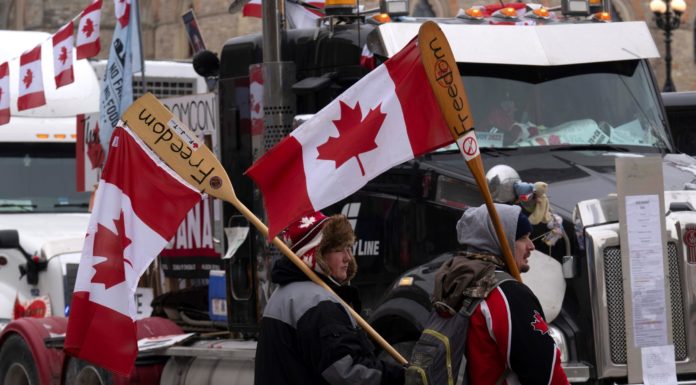(Associated Press) Ottawa police trying to break the nearly three-week siege of the capital by truckers protesting Canada’s COVID-19 restrictions began handing out leaflets Wednesday warning drivers to leave immediately or risk arrest.
Authorities in yellow “police liaison” vests went from rig to rig, knocking on the doors of the trucks parked outside Parliament, to serve notice to the truckers that they could also lose their licenses and see their vehicles seized under Canada’s Emergencies Act.
Police also began ticketing vehicles.
Some truckers ripped up the order, and one protester shouted, “I will never go home!” At least one trucker pulled away from Parliament Hill.
There was no immediate word from police on when or if they might move in to clear the trucks by force. But protest leaders braced for action on Wednesday.
Marie Eye, 43, of Victoriaville, Quebec, who has been making soup for the protesters, said she doubted police would be able to remove the rigs or the protesters.
“Well, so far they are just a piece of paper,” she said of the printed warnings. “We will see what happens. I don’t think they have the manpower to do it.”
The warnings came just days after Prime Minister Justin Trudeau invoked the emergency law, which gave authorities power to ban the blockades and tow away the trucks.
Since late January, protesters in trucks and other vehicles have jammed the streets of the capital and obstructed border crossings, decrying vaccine mandates for truckers and other COVID-19 precautions and condemning Trudeau’s Liberal government.
Just one blockade remained at the U.S. border, and the Royal Canadian Mounted Police said they expected the last remaining demonstrators to leave the site at Emerson, Manitoba, opposite North Dakota, by early Wednesday afternoon, with the Mounties escorting the vehicles out.
In Ottawa, the bumper-to-bumper demonstrations by the so-called Freedom Convoy have infuriated many residents, who have complained of being harassed and intimidated on the clogged streets.
Police in Ottawa were optimistic they could gain control in the coming days after Trudeau invoked the Emergencies Act on Monday.
Over the past weeks, authorities have hesitated to move against the protesters, citing in some cases a lack of manpower and fears of violence.
Trudeau’s decision came amid growing frustration with government inaction. Ottawa Police Chief Peter Sloly lost his job this week after he failed to move decisively against the demonstrators.
Interim Ottawa Police Chief Steve Bell said Tuesday he believes authorities have reached a turning point: “I believe we now have the resources and partners to put a safe end to this occupation.”
But protesters in the capital appeared to be entrenched. On Tuesday, Ottawa officials said 360 vehicles remained involved in the blockade in the city’s core, down from a high of roughly 4,000.
“They don’t want to give this up because this is their last stand, their last main hub,” said Michael Kempa, a criminology professor at the University of Ottawa.
Even after the warnings, a few protesters roasted a pig on the street in front of Parliament, and a child played with blocks in a small playground area on a road lined with trucks.
Police in the capital appeared to be following the playbook that authorities used over the weekend to break the blockade at the Ambassador Bridge connecting Windsor, Ontario, to Detroit. Police there handed out leaflets informing protesters they risked arrest. After many demonstrators left and the protest had dwindled, police moved in and made dozens of arrests.



